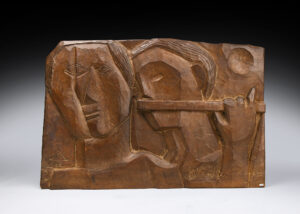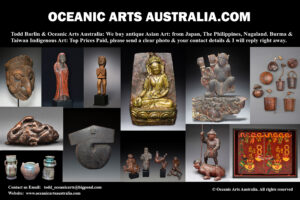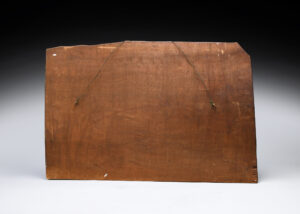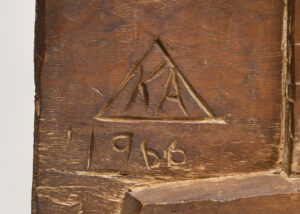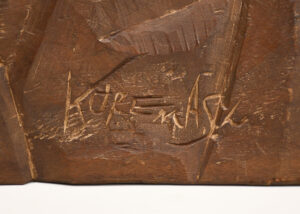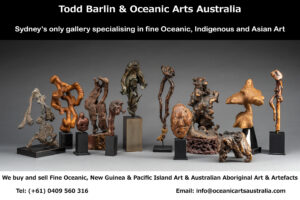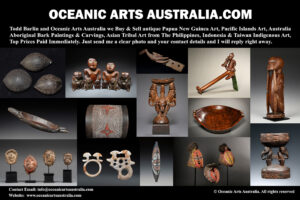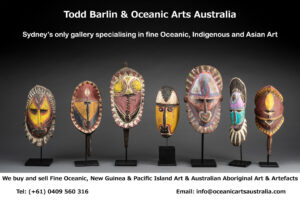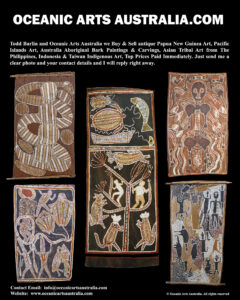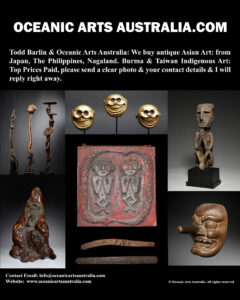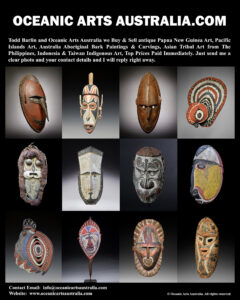A Superb Old Cubist Sculpture by by Japanese Artist Katsumi Koremasu Signed & Dated 1966
| Collection No. | TB-3934 |
|---|---|
| Size | (Size 71cm x 47cm) |
A Superb Old Cubist Sculpture by Japanese Artist Katsumi Koremasu Signed & Dated 1966
See more fine Japanese & Asian Art from my collection Here https://www.oceanicartsaustralia.com/asian-art/
This finely carved Cubist Sculpture by the Japanese Artist Katsumi Koremasu, dated 1966. You can see the cubist influence of Picasso and other early 20th-century Western Artists in this fine Sculpture. Carved from a single piece of hardwood, the two heads; one on the right playing flute and the figure on the left appear to sing with his mouth open, and his eyes are shown at different angles & sizes.
是松勝美 Katsumi Korematsu Born in (1931) Okayama prefecture, Japan
Graduated from Bunka Gakuen Art Department
Musashino Art University Carving Department
Member of Jiyubijutsu (Free Art) Association – Tokyo
Art Works Exhibited in
Matsumura Art Gallery – Nipponbashi, Tokyo
Nabisu Art Gallery – Ginza, Tokyo
Akasaka Gallery Sanko – Tokyo
Cubism is a Modern art movement that emerged around 1907 in Paris, France. Four important characteristics of Cubism are the application of multiple perspectives, the use of geometric shapes, a monochromatic colour palette, and a flattened picture plane.
Cubism’s novel handling of form, colour, and perspective signalled a shift from the existing conventions of European modernist painting. Cubism reimagined the treatment of form by rejecting the traditions of perspective, modelling, and foreshortening. The result of this method was a heavily abstracted composition that represented the subject from all angles or with overlapping picture planes.
Cubists intended to depict the entire structure of objects and people in their paintings without using techniques such as perspective or graded shading to make them look realistic. They wanted to show their subjects as they were rather than create an illusion of an object or person.
The use of linear perspective and the illusion of depth favoured by the Renaissance movement were in stark contrast to the two-dimensionality that Cubists worked to define. Cubist artists depicted their subjects from multiple perspectives simultaneously, working to represent every angle of the subject on the flat surface of a canvas and within a single picture plane.
Cube-like imagery, as well as other geometric forms like cones, spheres and cylinders often appear in early Cubist paintings and again later in the movement in Cubist sculptures. Cubists felt they could portray a subject’s form more accurately by using geometric shapes to represent its various sides and angles. The use of geometric shapes replaced techniques such as perspective and shading, which also emphasized the two-dimensional flatness of the canvas
Provenance: Old Japanese Collection & The Todd Barlin Collection of Oceanic & Japanese Asian Art
See my new EXHIBITIONS GALLERY showing the Museums and Art Galleries Exhibitions that I provided artworks for over the past 40 years. There is the link to the article about my artworks published in the prestigious Louvre Magazine in 1996
I have artwork for Museums and art Galleries but also for collectors at every stage of their collecting. I want to encourage people to explore the fine art of New Guinea & West Papua and the Pacific Islands and to be able to see and touch the artworks in a relaxed and friendly manner in my Sydney Gallery. I would like to invite you to visit my gallery and see the artworks in person and also look at my website www.oceanicartsaustralia.com where there are many Galleries & Sub Galleries to explore.
My Gallery of nearly 40 years is the last physical gallery in Sydney that specializes in New Guinea and Oceanic Art. Sydney is very close to New Guinea & the Pacific Islands where all of these amazing artworks came from, Australia’s closest neighbors.

